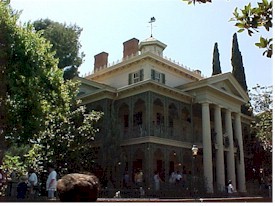30 years of the Haunted Mansion
Page 1 of 5
"We’re going to bring in ghosts from all over
the world. But we haven’t got the ghosts in there yet. We’re out collecting the
ghosts. We’re making it very attractive to them. Hoping, you know, they’ll come
and stay at Disneyland. We’re putting in wall to wall cobwebs and we guarantee them
creaky doors and squeaky floors."
- Walt Disney
Who knows what dark forces are lurking in that hulking mansion? If you were lucky enough to watch it grow from the Disneyland landscape, you waited for what was an unbearable amount of time for the spooks to finally come home to roost. If you arrived after the opening, you were greeted with the pristine gardens and facade of this New Orleans estate. Then while you spent your time in the queue, silent tombstones of birds, frogs, and even a few humans urged you to ponder your fate inside the big white house.

The Haunted Mansion Today
The origins
The Haunted Mansion made its first appearance in Disneyland mythology during the creative "sell the concept to the bankers" phase of the park’s development. In many drawings Main Street was portrayed as having a residential district. One of those drawings was by Harper Goff, penned sometime between ’51-’53, and included a Haunted Mansion up a hill above a residential district. But the residential district was lost to space constraints and other considerations, and with it went the first glimpse of a haunted mansion.
The story ideas (1957)
The idea was resurrected in 1957 with drawings by Imagineers Ken Anderson and Sam McKim. Ken and Sam transformed what had been envisioned as a stately New England Manor into a declining New Orleans Mansion. Walt nixed these ideas. He didn’t want anything that looked rundown in his theme park.
During this time many ideas were thrown together on the drawing board by Ken Anderson. The book The Nickel Tour and the Doombuggies website both have great looks at what the Haunted Mansion could have been. When the attraction wasn’t yet placed in the New Orleans Square environs, one story centered around the story of a sea captain, his bride, and tales of horrible vengeance. Another tale involved a headless horseman.
The attraction was conceived at various times as a walk-through museum, a ride on a moving platform, or a ghostly tour. In the walk-through version two identical show buildings were considered to increase throughput to the numbers needed to justify the existence of the attraction.
For various reason, the idea of building a Haunted Mansion in Disneyland was shelved. The park went on to open many new attractions, including the 1959 Tomorrowland expansion.
Let’s try this again, shall we (1962 - 1969)
As they say, a good idea never dies. And so the Haunted Mansion breathed back to life again in 1962. Walt Disney moved Yale Gracey from the studio to WED (now known as Walt Disney Imagineering). He, and his assistant Rolly Crump, were assigned a special room at the studio to build effects that could be used in a haunting future attraction. Among the many projects considered was The Museum of the Weird. It was never clear if any of these projects would make it to fruition. As it turns out many tricks, props and effects from Yale’s special room made it directly into the Haunted Mansion. Among these are the singing busts and Madame Leota.
On the strength of these ideas Walt had the grand facade of the Manor we see today built in 1963. However, once built the mansion sat empty, jilted, as things were put on hold for the ’64-’65 World’s Fair. A sign was hung advertising for 999 ghostly residents.
Once the World’s Fair was up and running, the folks at WED had time to focus again. Alas, they didn’t focus on the Haunted Mansion. Instead they turned their attention toward moving the fair’s shows to Disneyland, finishing New Orleans’s Square and a whole new ride, The Pirates of the Caribbean. Then they started another project you might have heard of, the 1967 redo of Tomorrowland.
